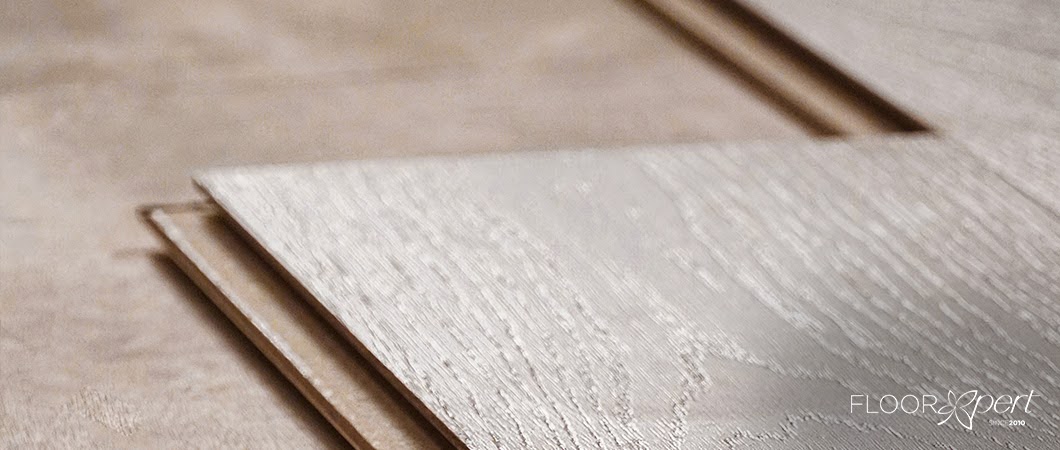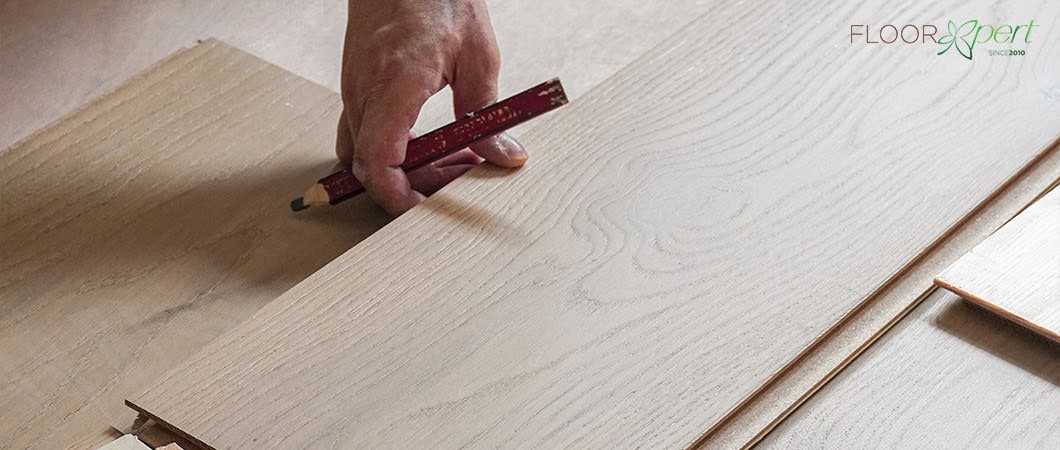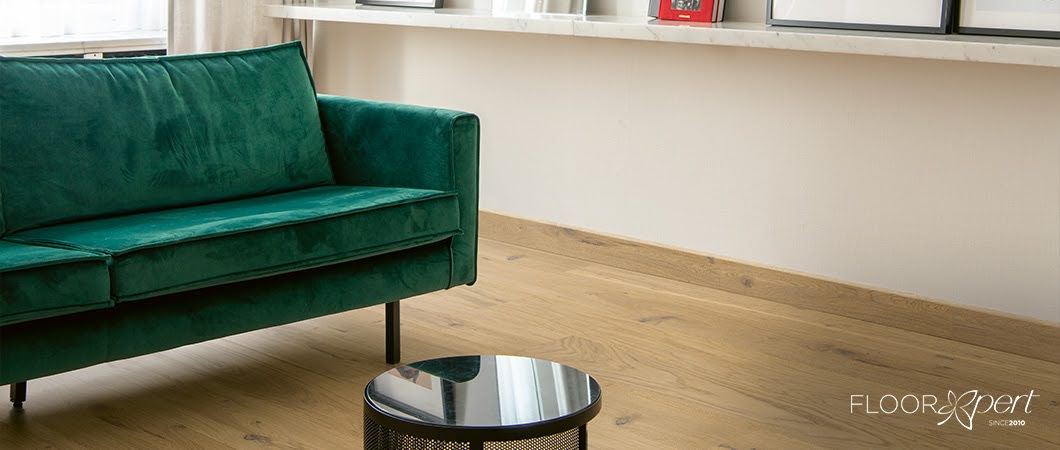 The flooring in your home does more than provide a surface to walk on—it plays a crucial role in setting the tone for your space. From style and texture to durability, the right flooring can make your home more comfortable, functional, and aesthetically pleasing.
The flooring in your home does more than provide a surface to walk on—it plays a crucial role in setting the tone for your space. From style and texture to durability, the right flooring can make your home more comfortable, functional, and aesthetically pleasing.
Amongst the choices available today, engineered wood stands out as an increasingly popular choice. It combines aesthetics and practicality, showcasing the elegance of natural wood with added benefits that make it suitable for various needs.
In this guide, we’ll explore everything you need to know about engineered wood flooring, from its features and designs to installation and maintenance, to help you decide if it’s the best fit for your home.
What is Engineered Wood Flooring?
Composition and Construction
Engineered wood is a type of multi-layer flooring that combines natural wood with advanced engineering techniques.
At its core is a high-quality base layer made from plywood, MDF (Medium-Density Fibreboard), or sometimes HDF (High-Density Fibreboard). This core layer forms the structural foundation of the flooring, offering stability as well as resistance to fluctuations in temperature and humidity.
On top of the core layer lies a thin but durable real wood veneer, which provides the authentic look and feel of solid hardwood flooring. This showcases the wood’s natural grain and texture and gives the flooring its premium aesthetic.
Completing the structure is the backing layer, typically made of stabilising material like plywood or hardwood. This layer prevents common issues like warping, bowing, or buckling over time, ensuring that the entire plank remains stable and balanced.
This layered construction is what gives engineered wood flooring its durability and versatility, making it an excellent choice for areas where solid hardwood may not be practical, such as kitchens, basements, or other high-moisture zones.
Types and Designs
In addition to its functionality, homeowners can choose from a variety of engineered wood flooring types to suit their preferences.
1. Wood Species
Engineered wood flooring is available in a wide range of wood species, each bringing its unique personality to your space. Classic options like oak, walnut, and maple remain classic favourites for their sophisticated appearance and grain patterns. Oak, for example, offers neutral tones and subtle grains, making it ideal for both modern and traditional interiors. If you’re seeking something more exotic or distinctive, teak boasts rich tones that contribute to a warm, luxurious atmosphere.
2. Surface Textures
Aside from protecting the surface, the texture chosen also affects the overall look and feel of your flooring. Matte and satin textures fit well into modern homes, offering a subtle, understated elegance that works well in minimalist or Scandinavian-inspired interiors. Glossy textures add a touch of luxury for a more dramatic effect, creating a polished, high-end vibe.
3. Textured Finishes
On the other hand, texture finishes bring a unique personality to your flooring. Hand-scraped textures, for instance, offer a vintage, farmhouse-inspired look that captures the natural imperfections of wood, giving it a lived-in charm. Wire-brushed finishes are another popular choice, subtly accentuating the wood grain while creating a tactile surface that’s resistant to wear and tear. A simple yet elegant option should be Floor Xpert’s Castello Collection, with its V-groove detail that enhances the natural look of wood while adding a touch of sophistication.
4. Plank Sizes and Patterns
Did you know that the size and layout of your planks can also impact the perception of your space? Wide planks are a popular choice for modern interiors, as their larger surface area creates an open, expansive feel. Narrow planks, in contrast, have a more traditional charm and are perfect for homeowners aiming for a classic or cosy aesthetic.
Those looking to make a bolder statement can opt for intricate patterns like chevron and herringbone, as showcased in the Disegno Collection. These patterns add a bespoke, designer element to any room, elevating the overall look and feel of your home.
Why Choose Engineered Wood Flooring Over Solid Hardwood?
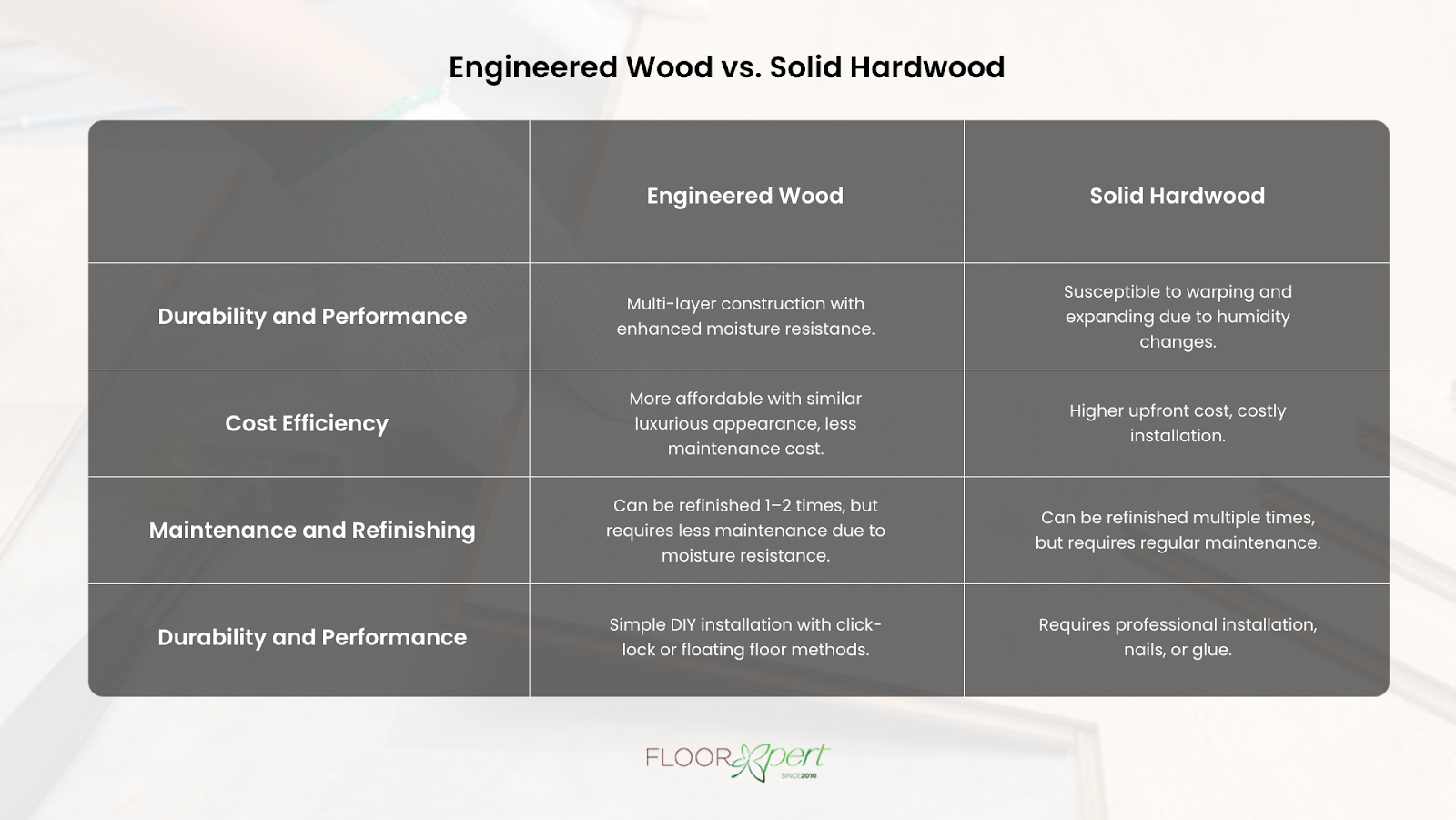
So, what exactly is the difference between engineered wood flooring and solid hardwood? Here are some of the differences.
1. Durability and Performance
Solid hardwood struggles in environments with high humidity or fluctuating temperatures, often expanding, warping, or contracting, which can lead to costly repairs. In contrast, engineered wood flooring is designed to withstand these challenges. Its multi-layer construction offers enhanced moisture resistance, making it ideal for Singapore’s tropical climate.
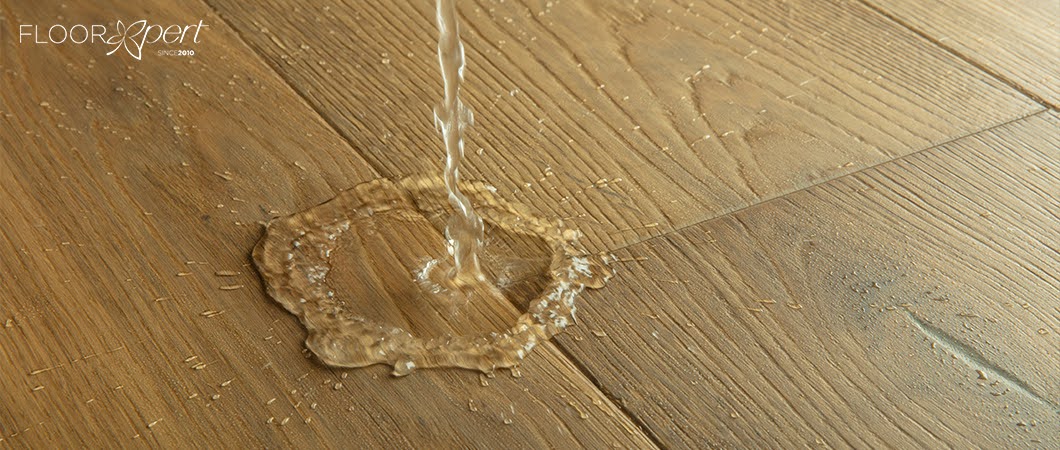
For example, Floor Xpert’s Cascada range is equipped with a Hydroseal coating on all four sides, preventing water from seeping through and damaging the underside of the floor. This watertight feature allows water to remain on the surface for up to 72 hours without causing damage, providing exceptional durability and protection.
2. Cost Efficiency
Solid hardwood is typically more expensive due to the cost of raw materials and labour-intensive installation methods. Engineered wood flooring delivers the same luxurious look at a more budget-friendly price. Its durability and lower maintenance needs also result in fewer repairs and reduced upkeep, making it a cost-effective long-term investment for homeowners.
3. Maintenance and Refinishing
While solid hardwood can be refinished multiple times thanks to its thick planks, engineered wood flooring can only be refinished once or twice, depending on the veneer’s thickness. However, engineered wood compensates with its moisture resistance and overall durability, which reduces the need for refinishing and frequent repairs.
4. Installation Flexibility
Solid hardwood requires professional expertise and time-consuming methods, such as nailing or glueing each plank to the subfloor. This process can be labour-intensive, requiring precise measurements and meticulous work, increasing installation time and costs.
In contrast, engineered wood flooring is easier and more cost-effective to install. This flexibility also reduces the overall cost and time needed for setup, making engineered wood a convenient option for many homeowners.
A Guide to Installing and Maintaining Engineered Wood Flooring
Types of Wood Floor Installation Methods
1. Floating Installation
The floating installation method features planks with interlocking edges that securely snap together, creating a stable floor without the need for glue, nails, or extra tools. This makes the installation process quick, clean, and efficient—ideal for homeowners looking for a hassle-free DIY solution. Additionally, the system allows the flooring to be installed “floating” over most existing floors, which can save both time and the expense of subfloor preparation. It’s a great option for those who want a convenient and mess-free installation experience.
2. Glue-Down Installation
Glue-down installation involves applying a layer of adhesive directly to the subfloor before laying the engineered wood planks on top. The permanent bond it creates ensures its stability, making it ideal for larger rooms or high-traffic areas. The adhesive provides a firm hold, reducing the potential for movement or creaking over time.
Although it can be more time-consuming compared to click-lock installation, glue-down installation delivers a high-quality, secure floor that’s built to last. It also creates a quieter floor, as the adhesive helps eliminate any gaps that might otherwise cause noise or movement.
3. Nail-Down Installation
Nail-down installation is a more traditional approach, often used for larger flooring projects. In this method, the planks are nailed directly into the subfloor, providing a secure and long-lasting connection. This technique may be more suitable for expansive areas and spaces with heavy foot traffic, offering superior stability. This makes it an ideal choice for projects where long-term durability is a priority, such as office or commercial spaces.
Although this method creates a solid floor that won’t shift or move over time, it also requires more expertise and time than the click-lock or glue-down options.
Care and Maintenance Tips for Engineered Wood Flooring
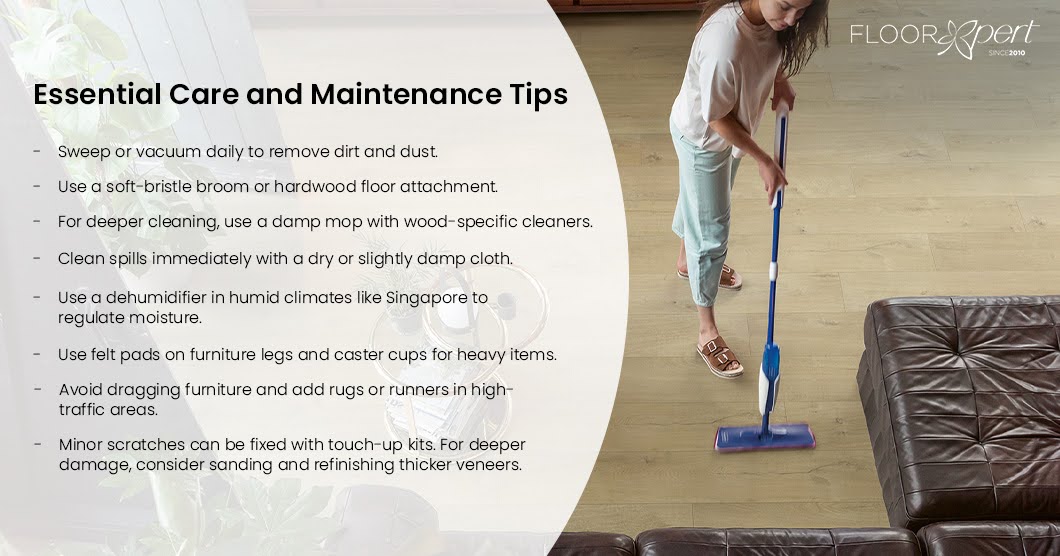
Although engineered wood flooring is naturally built to last, proper care and maintenance are still essential to keep it looking its best for years.
1. Cleaning Tips
Maintaining the beauty of your wooden flooring starts with regular cleaning. Sweeping or vacuuming daily helps remove dirt, dust, and debris that can cause scratches or wear on the surface. However, make sure to use a soft-bristle broom or a vacuum cleaner with a hardwood floor attachment to prevent accidental damage.
When deeper cleaning is needed, use a damp mop with cleaning agents specifically formulated for engineered wood flooring. Avoid harsh chemicals or excessive water, as they can erode the finish and weaken the flooring over time.
2. Moisture Control
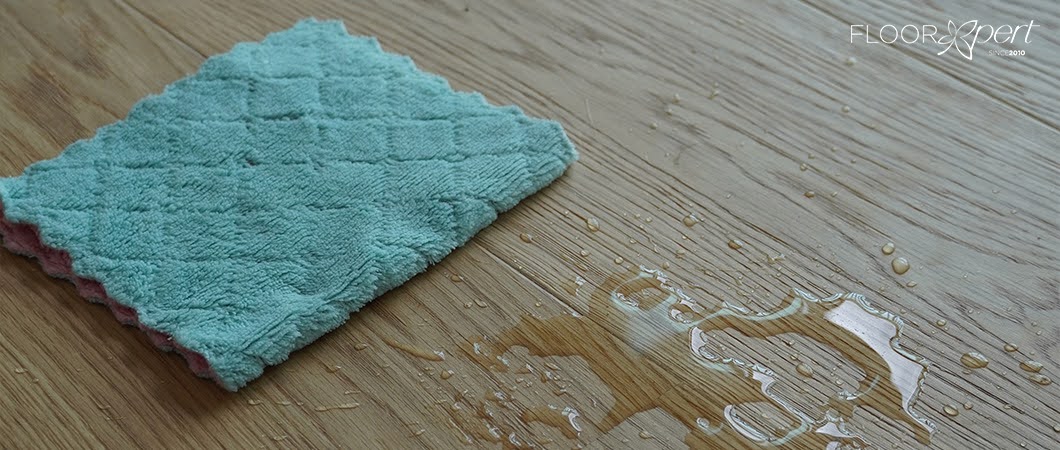
While engineered wood floors are moisture-resistant, they are not immune to damage from prolonged exposure to water or humidity. Always make sure to clean up spills completely using a dry or slightly damp cloth. In humid climates like Singapore, consider using a dehumidifier to regulate indoor moisture levels and maintain the floor’s integrity. As a precautionary measure, it may be best to place mats near entryways and sinks to catch spills or excess water.
3. Protecting Against Scratches
Keep your flooring pristine and scratch-free by placing felt pads under furniture legs and using caster cups for heavy items. Avoid dragging furniture or sharp objects across the floor, as these actions can cause irreparable damage. Consider adding rugs or runners in areas that see lots of activity, such as living rooms or hallways. These will act as a buffer against everyday wear and tear while complementing your home’s décor.
4. Repair and Refinishing
Even with careful maintenance, occasional scratches or dents may appear over time. Minor scratches can often be repaired with touch-up kits that match the floor’s colour and finish. For more significant wear, engineered wood floors with a thicker top veneer can be sanded and refinished once or twice to restore their original shine. However, always consult the manufacturer’s guidelines or a professional flooring contractor before refinishing to avoid damaging the flooring beyond repair.
Frequently Asked Questions
How long does engineered wood flooring last?
The lifespan of your flooring can vary depending on factors like the thickness of the top veneer, the quality of the product, and how well it’s cared for. With proper maintenance, such as regular cleaning and protecting the floor from excessive moisture and scratches, engineered wood can last 20 to 30 years or even longer. Higher-quality options with thicker veneers can often be refinished, giving them even more longevity. While areas with heavy foot traffic may show signs of wear sooner, using rugs or mats in these zones can help preserve the surface and keep your floors looking great for years.
What is the difference between engineered and solid wood?
Engineered wood consists of three layers of real wood, offering greater stability and less expansion or contraction than solid wood, which is made from a single piece of wood. Engineered wood is more eco-friendly, easier to install, and requires less maintenance. It can also be sanded multiple times. In contrast, solid wood needs more maintenance, including sanding and finishing. Finally, engineered wood can be installed using a simple click system, while solid wood typically requires glue-down installation.
How do I remove stains from engineered wood flooring?
Spilled wine or dye on your floor? Don’t panic. Start by gently blotting the area with a clean, dry cloth to absorb as much liquid as possible. Avoid rubbing, as this can spread the stain further. For tougher stains, use a cleaner specifically designed for wood floors. If you don’t have one, you can create a mild solution by mixing a small amount of dish soap with warm water.
How do I protect my engineered wood floor from fading?
Direct sunlight for prolonged periods can cause wooden flooring to fade. You can avoid this by using curtains or blinds, especially in rooms with large windows, to help protect the finish. Regularly cleaning the floor and adding felt pads to furniture legs can also prevent long-term wear and help maintain its appearance.
Make the Smart Choice: Engineered Wood for Timeless Beauty
To sum up, engineered wood flooring is a versatile and reliable option for homeowners. Its robust construction, wide range of design choices, and simple installation methods make it an ideal solution for any space. With proper care and maintenance, you can enjoy flooring that is not only beautiful but can also stand the test of time.
Ready to transform your space? Let Floor Xpert help you bring your vision to life. We offer a wide range of engineered wood flooring options, from sleek, modern designs to warm, rustic finishes, all crafted for durability and beauty. Our team is here to provide expert advice and ensure you find the best choice for your style, budget, and needs.
Book an appointment with us today.
